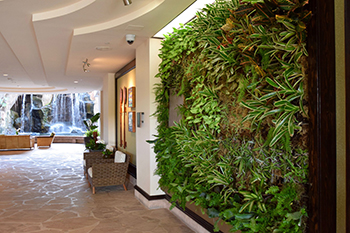 MAUI, Hawaii — When a state relies on tourism as its main source of revenue, it can be difficult to prioritize environmental sustainability over the comfort of guests, but Maui resorts are finding a balance in going green. Three standout resorts are reducing water waste, using and recycling local products, and focusing on alternative energy.
MAUI, Hawaii — When a state relies on tourism as its main source of revenue, it can be difficult to prioritize environmental sustainability over the comfort of guests, but Maui resorts are finding a balance in going green. Three standout resorts are reducing water waste, using and recycling local products, and focusing on alternative energy.
1. Westin Maui’s Resort & Spa in Lahaina, one of 11 hotels chains under the Starwood brand, has pledged 30/20 by 20, which calls for a 30 percent reduction in energy use and a 20 percent reduction in water consumption per hotel room by 2020.
In April, Westin Maui won the Excellence in Sustainability award at the 2016 Aipono Restaurant Awards. In food service, the hotel uses locally sourced and harvested ingredients instead of shipping products from the mainland, recycles kitchen oil through Pacific Biodiesel and serves food in biodegradable containers. Partnerships with local farmers also go both ways: Farmers provide food to the Westin Maui, and in turn, the food waste from the hotel is repurposed for pig food at local farms.
In housekeeping, Westin Maui offers Starwood points or dining credits for those that defer daily service, which saves almost 40 gallons of water, 25,000 BTUs of natural gas and 7 ounces of chemicals from being used per day. Housekeepers also get 5 cents for every beverage bottle they recycle. The landscape now uses native drought-resistant plants, pre-dawn watering and reef-friendly fertilizers. Green waste such as tree cuttings and palm fronds is recycled by Maui Eko Systems and then bought back as fertilizer or mulch by the resort.
2. The Hyatt Regency Maui Resort and Spa in Ka’anapali recently completed a large rooftop solar panel system in February in order to reduce CO2 emissions. Hyatt officials expect the solar panels to generate 6 percent of the resort’s annual electric needs, which is the equivalent to the amount used in 158 grid homes.
“We are currently in the process of introducing a sustainability tour around our property that will increase awareness of the different areas that we are making environmental advancements, including water efficiency, ocean and reef protection, minimizing food waste, recycling, solar energy, air quality and green cleaning,” said Gary Bulson, senior engineer at Hyatt Regency Maui Resort and Spa, in a recent press release.
Housekeeping now uses Ecolab cleaning products. High-efficiency, low-flow showerheads, which were retrofitted into the rooms, have saved 6 million gallons of water a year. Motion-sensing, air-conditioning units turn off when doors are open among or guests are not in the room. The Hyatt is a LEED EBOM (Existing Building Operations and Maintenance) Silver-certified resort, the first of its kind in Hawaii.
3. The Fairmont Kea Lani in Wailea debuted a 500-kilowatt photovoltaic system this month, predicting a reduction of 457 metric tons of CO2 annually and a 10 percent offset of energy demand. The Fairmont has more than 50 environmental initiatives in the works, including using rock salt instead of chlorine in swimming pools and dining utensils made from potatoes instead of plastic. The Willow Stream Spa, part of the Fairmont, also uses fresh and local herbs — like its kitchen counterpart — in its massage oils.
The Fairmont also partnered with The U.S. Fish and Wildlife Service and Hawaii’s Department of Land and Natural Resources to create a volunteer patrol program for the endangered hawksbill sea turtle. The resort’s sustainability team walk the beach every morning through nesting season to report tracks and nests.

